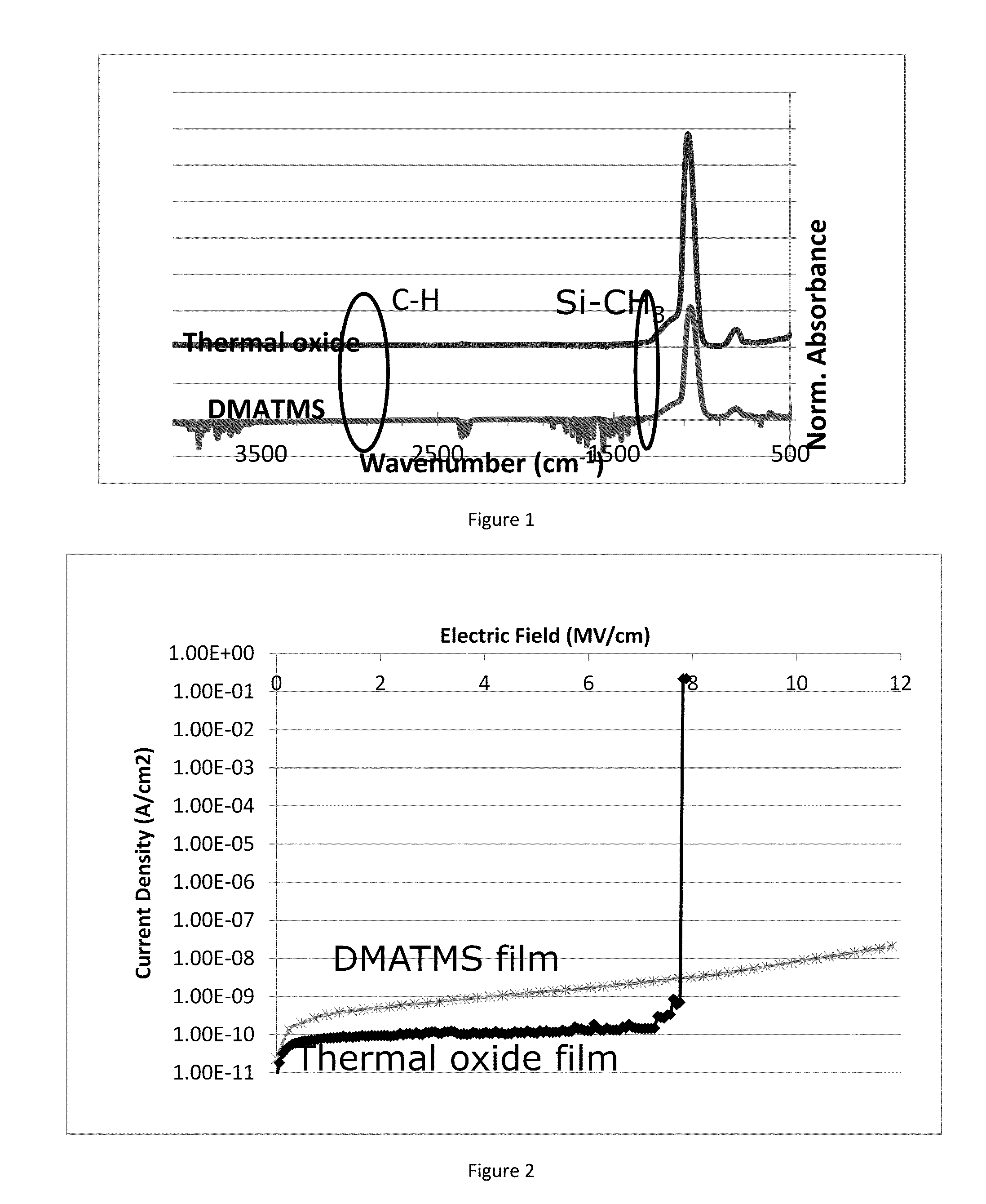Compositions and methods for the deposition of silicon oxide films
a technology of silicon oxide and composition, applied in the field of composition and method for the formation of silicon oxide containing films, can solve the problems of difficult removal of sih* surface species from tdmas, low temperature silicon oxide deposited using these processes, etc., and achieve enhanced ald, enhanced cyclic chemical vapor deposition, and enhanced ald-like process
- Summary
- Abstract
- Description
- Claims
- Application Information
AI Technical Summary
Benefits of technology
Problems solved by technology
Method used
Image
Examples
example 1
Synthesis of Bis(sec-butylamino)methylsilane
[0105]A solution of dichloromethylsilane (110 g, 0.956 mol) in hexanes (200 mL) was added drop wise over 1 hour via addition funnel to a stirred solution of sec-butylamine (308 g, 4.21 mol) in hexanes (1.5 L). The resulting white slurry was warmed to room temperature and allowed to stir overnight. The solids were removed by vacuum filtration over a glass frit and washed twice with hexanes. The combined filtrates were distilled at 1 atmospheres (atm) to remove most of the solvent and excess amine. The crude product was then purified by vacuum distillation (92° C. / 30 torr) to obtain 111 g of bis(sec-butylamino)methylsilane (b.p.=192° C. gas chromatography-mass spectroscopy (GC-MS) peaks: 188 (M+), 173 (M-15), 159, 143, 129, 114, 100, 86, 72). About 2.0 g of bis(sec-butylamino)methylsilane was loaded into each of 3 stainless steel tubes inside a nitrogen glove box. The tubes were sealed and placed in oven at 60° C. for 4 days. Samples were an...
example 2
Synthesis of Bis(iso-propylamino)methylsilane
[0106]A solution of dichloromethylsilane (109 g, 0.0.948 mol) in hexanes (200 mL) was added dropwise over 1 hour via addition funnel to a stirred solution of iso-propylamine (243 g, 4.11 mol) in hexanes (1.5 L). The resulting white slurry was warmed to room temperature and allowed to stir overnight. The solids were removed by vacuum filtration over a glass frit and washed twice with hexanes. The combined filtrates were distilled at 1 atm to remove most of the solvent and excess amine. The crude product was then purified by vacuum distillation (70° C. / 53 torr) to yield 93 g of bis(iso-propylamino)methylsilane (b.p.=150° C.; GC-MS peaks: 160 (M+), 145 (M-15), 129, 117, 100, 86, 72). About 1.5 g of bis(iso-propylamino)methylsilane was loaded in each of 2 stainless steel tubes inside a nitrogen glovebox. The tubes were sealed and placed in oven at 80° C. for 3 days. Samples were analyzed to show assay dropped about 0.14%, which demonstrated t...
example 3
Synthesis of Bis(diethylamino)methylsilane
[0107]A solution of dichloromethylsilane (100 g, 0.869 mol) in hexanes (200 mL) was added dropwise over 1 hour via addition funnel to a stirred solution of diethylamine (280 g, 3.83 mol) in hexanes (1.5 L). The resulting white slurry was warmed to room temperature and allowed to stir overnight. The solids were removed by vacuum filtration over a glass frit and washed twice with hexanes. The combined filtrates were distilled at 1 atm to remove most of the solvent and excess amine. The crude product was then purified by vacuum distillation (78° C. / 16 torr) to yield 103 g of bis(diethylamino)methylsilane (b.p.=189° C.; GC-MS peaks: 188 (M+), 173 (M-15), 159, 145, 129, 116, 102, 87, 72).
PUM
| Property | Measurement | Unit |
|---|---|---|
| temperatures | aaaaa | aaaaa |
| density | aaaaa | aaaaa |
| density | aaaaa | aaaaa |
Abstract
Description
Claims
Application Information
 Login to View More
Login to View More - R&D
- Intellectual Property
- Life Sciences
- Materials
- Tech Scout
- Unparalleled Data Quality
- Higher Quality Content
- 60% Fewer Hallucinations
Browse by: Latest US Patents, China's latest patents, Technical Efficacy Thesaurus, Application Domain, Technology Topic, Popular Technical Reports.
© 2025 PatSnap. All rights reserved.Legal|Privacy policy|Modern Slavery Act Transparency Statement|Sitemap|About US| Contact US: help@patsnap.com



